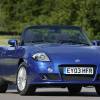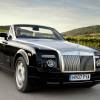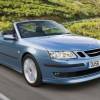
RAC sale – up to 33% off*
• Roadside cover from £5.29 a month†
• We get to most breakdowns in 60 mins or less
• Our patrols fix 4/5 breakdowns on the spot

BY ANDY ENRIGHT
Introduction
The Mercedes SL has long stood for refined elegance and continent crushing ability but it was only with the introduction of the 2002 model year car that the Sport part of the SL's 'Sport Leicht' designation could justify its existence. The previous model was neither sporty nor lightweight and although the later car still doesn't so much tip the scales as total them, Mercedes have made the effort to endow the car with some genuine dynamic prowess. Opt for one of the more powerful versions and you get a car with supercar performance but with accoutrements that would do most luxury saloons proud. The best SL to date? Most would agree.
Models
Models Covered: 2dr Coupe/Convertible (SL350, SL500, SL55 AMG, SL600, SL65 AMG)
History
Mercedes opened the book on what they codenamed the R230 series SL as they meant to go on, with a pair of powerful V8 engined models landing in UK dealerships in March 2002. The 306bhp SL500 opened proceedings at a cool £67,610 with the rocketship 476bhp SL55 AMG model topping the tree at £88,860. Critics instantly raved about the SL's combination of pace and panache but this was just the first tranche of models that Mercedes were to unleash. An entry-level 245bhp V6 SL350 followed in early 2003 and by July a monster 493bhp SL600 twin turbocharged V12 had been unveiled. This was duely followed by the ultimate SL, the SL65 AMG with its 612bhp output and a pricetag in excess of £145,000.
A series of changes were introduced in early 2006, including a revised front bumper assembly with three large cooling air intakes integrated and a matte silver finished grille with three broad slats. The interior was smartened-up as well with changes also being made to the engines. The SL500 was increased from 306bhp to a brawny 388bhp and the SL350 went from 245bhp to 272bhp.
What You Get
Whereas big Mercedes SEC coupes from the early eighties now look a bit blousy, the SL retained a classical purity of line. Replacing such a car was never going to be easy, Mercedes designers precariously perched beneath the historical baggage of Damocles. First impressions were disappointing. Advance press pictures from the 2001 Frankfurt Motor Show gave the impression that the car was little more than a mild reskinning of the old model with some fussy detailing. The reality could hardly be more different.
Designers have a particularly clumsy term for describing a car that just works in the metal - 'front to rear cohesiveness'. The SL has this quality in spades. Every curve melds into the next, flop lines and swages teasing, pouring and sweeping light from one plane to the next. The balance between slavishly unimaginative retro styling and the preservation of traditional; design cues explains some of the more contrived punctuations but the overall effect is supremely elegant. The roof mechanism has stepped forward a generation from that of the SLK, lifting or lowering in a mere 16 seconds with a panel fit only bettered by the ALVIN deep sea submersible.
The interior quality is what we've come to expect from Mercedes - premium price rather than Fisher Price, although the car looks far better specified with aluminium cabin detailing than optional lumber. The 'conjoined twin' front headlamp theme continues in the cabin with neat wheel-mounted controls whilst the main fascia dials excise neat arcs from the minor gauges.
What You Pay
Please fill in the form here for an exact up-to-date information.
What to Look For
Mercedes' engines, like the cars, last virtually forever as they're always under-stressed. Watch out for oil leaks, though. Avoid manual cars at all costs and anything without a proper service history. The gearchange is slow and heavy and when you sell on you'll find buyers are simply not interested in anything other than automatics. Check all those electronic 'toys' like the central locking, electric windows and air conditioning.
Replacement Parts
(Based on a '02 SL500 and exclusive of VAT) A full exhaust will be around £1750. Brake pads are approximately £65 for the front and £40 for the rear. An alternator is just under £200 and a starter motor roughly £180. A headlamp unit is about £325 and a radiator should come in at about £360.
On the Road
Mercedes went to great lengths not only to make the car safer, cleverer, quicker and cleaner than its predecessor but also to improve the dynamics of the car. The SL was never a car that would look upon a corner with any great relish but this model not only shed weight - due in no small part to extensive usage of aluminium body panels - but the V8 models also feature the astonishing automatic body control (ABC) system used to such devastating effect in the behemoth Mercedes CL coupe. An enhanced version of ABC was also offered as an option on the SL350 after the 2006 facelift, while remaining standard on the SL500 and SL600 derivatives.
Thus equipped, the Mercedes SL doesn't roll through corners yet does without the attendant bone-shaking ride quality you'd expect from such a taut handling car. This is due to a set of electro hydraulics that lower the ride height when the 'Sport' button is jabbed. Combined with the ESP stability control system it gives the Mercedes a strangely artificial feel when cornering hard, the driver unsure of the limit, feedback suppressed by several white-coated Stuttgart boffins. Turn the ESP off and the SL will happily display its lairy side. If you can overcome the initial unease, the SL is extremely capable and, dare we say, fun. Most sporting Mercedes models seemed to wilfully introduce impediments to the process of enjoyment, either lazy automatic gearboxes, laughably poor manual gearchanges, vague steering via steering wheels that resembled something from the Cutty Sark or woolly chassis. It appears the killjoys never got their hands on the SL's design.
The SL500 features a five-speed automatic gearbox that you can bully through manually, but the software beneath it is sufficiently sweet and intuitive to render changing gear yourself redundant. The range consists of the 3.7-litre 245bhp SL350 (upgraded to 272bhp in 2006), the 306bhp five-litre SL500 (upgraded to 388bhp in 2006), the 476bhp SL55 AMG, the 493bhp bi-turbo V12 SL600 (upgraded to 517bhp in 2006) and the SL65 AMG.
The SL55AMG is a car which covers the sprint to 60mph in just 4.7 seconds on the way to a limited top speed of 155mph. With a torque figure of 700Nm (more than a Lamborghini Diablo GT!) the SL55 is something quite special. Which makes the SL65 faintly ridiculous with its 612bhp and 4.2s 0-60mph time.
In keeping with the SL's high-tech outlook, Mercedes has developed Sensotronic (the first brake-by-wire technology for a road car) for the SL. Hydraulics have been replaced by electronics which can prime the braking system by lightly applying the pads to the discs when the accelerator pedal is suddenly released, reducing stopping distances by some 3%. In wet conditions the pads can skim the discs of friction-reducing water.
Overall
Any car that can make a Porsche 911 Cabrio look a touch dated has to be very special indeed, but the Mercedes SL manages it easily. Shedding its image as the weapon of choice for the chunky-chained leather-complexioned boulevardier has been surprisingly easy. Used examples are by no means inexpensive but they do represent good value for money when one considers the excellence of the product on offer.

![Mercedes-Benz SL [R230] (2001 - 2008) used car review](https://d1ix0byejyn2u7.cloudfront.net/drive/images/made/drive/images/remote/https_d2yv47kjv2gmpz.cloudfront.net/filestore/1/5/0/2_00530ed2277a496/40f3f430a9ab7b30160400f11d40500c/2051_7c8efca5da46715_794_529_70.jpg)





